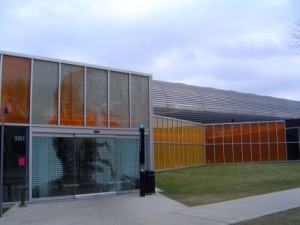After having read about Lynch’s identification of five characteristics of place (paths, edges, districts, nodes and landmarks), I thought it might be interesting to try a mapping exercise with the class. I gave my classmates an index card and asked them to draw their way from our studio in Burruss to the Au Bon Pain in Squires on the other side of campus; the results were quite interesting.
Of the six participants (and I’m excluding the professor, who drew another map – from Studio to GBJ), 3 used both the front and back of the index cards. All drew in pen, 4 in black ink, 1 in red, 1 in blue. Everyone drew stairs in some shape or form, 2 drew the stairs in elevation (interesting, since the readings note that it is easier for people to visualize themselves as aerial observers).
Paths: most individuals only drew a line as indicative of their trajectory, while a few also drew the paths that ran perpendicular to their own parcours, or paths they crossed along their way.
Edges: the Drillfield was defined as an edge condition in one drawing. Buildings were treated as masses and edges.
Districts: the Drifllfield, treated as a mass, read as a district in the majority of the drawn maps.
Nodes: there were almost no nodes in these drawing, even though there are points along the way that are large intersections of pedestrian sidewalks; the only node noted on the majority of the drawings is the fork in the Drillfield (exit access to Prices Fork Road).
Landmarks: stairs and buildings were treated as landmarks; one individual noted what appear to be quads as landmarks, as well.
What I found even more interesting (as I tried to watch while I drew) was the order in which people drew their maps. The readings noted that laying out a grid (working large) and then mapping a path (working small) was a sign of a more developed intellect – I am inclined to disagree (not just because I didn’t do it that way…). Most people drew their landmarks, their edges, their guides, if you will, as they went. These are, mind you, all seniors and juniors in college, trained to think visually. And, they had all done the readings, so unless they wanted to be thought of as less intelligent, they veritably thought this process of drawing the map was the best way to express their intent!
I found the readings on Lynch to be most valuable to my thesis research, as well, since they attempt to pinpoint the way in which we remember place. The readings mentioned Tuan, and I went back to my notes on Tuan’s Space and Place, which led me to some interesting notes about the relationship of the individual to place, particularly his note: “When space feels thoroughly familiar to us, it has become place.” Implicit in this statement is the reading’s references to use and attachment – when people frequent a building, they are more likely to become attached to it (give it the moniker of place). So, as the reading notes, if hospitals are less likely to become places because people don’t frequent them (unless they have a chronic illness), and this is a condition applicable to a variety of places (anything that isn’t a First, Second or Third Place, really – post offices, gas stations, etc.) – what can we, as designers, do to make Tuan’s man “fall in love at first sight with a place as with a woman”? Must we live with spaces, or can any space become a place?

